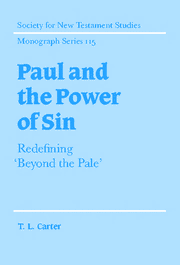Book contents
- Frontmatter
- Contents
- List of figures
- Preface
- List of abbreviations
- 1 Introduction
- 2 ‘Grid and group’
- 3 Physical and social boundaries in Corinth
- 4 Exclusive boundaries in Galatia
- 5 Small bounded groups in Rome
- 6 Inclusive boundaries in Rome
- 7 Conclusion
- Bibliography
- Index of selected subjects
- Index to ancient references
3 - Physical and social boundaries in Corinth
Published online by Cambridge University Press: 22 September 2009
- Frontmatter
- Contents
- List of figures
- Preface
- List of abbreviations
- 1 Introduction
- 2 ‘Grid and group’
- 3 Physical and social boundaries in Corinth
- 4 Exclusive boundaries in Galatia
- 5 Small bounded groups in Rome
- 6 Inclusive boundaries in Rome
- 7 Conclusion
- Bibliography
- Index of selected subjects
- Index to ancient references
Summary
Introduction
1 Corinthians contains only one isolated reference to the power of sin, in 15:56. This verse, which may well be a gloss, speaks of the law as the power of sin. Nevertheless, the subject of sin was never far from Paul's mind as he wrote to the wayward church at Corinth and thus a chapter on 1 Corinthians earns its place in this study on Paul's hamartiology. On the basis of a comparison with the sin language of 1 Corinthians, it will be possible to see whether or not Paul's use of the symbolism of the power of sin in Galatians and Romans represents a significant difference in his understanding of the human condition. This chapter will use Douglas' Grid and Group matrix to analyse 1 Corinthians, with a view to analysing the social location of Paul and the Corinthians and the influence their social location has on their different perceptions of sin. In this way, it will be possible to perceive how Paul's sin language would have been understood (or misunderstood) by the letter's original readers in the socio-cultural setting of first-century Corinth. It will also be possible to test the usefulness of the model, by seeing whether or not it can yield any fresh exegetical insights into the hamartiology of this particular letter.
A chapter on 1 Corinthians is also required because numerous scholars have applied Douglas' model to this letter and have come to substantially differing conclusions.
- Type
- Chapter
- Information
- Paul and the Power of SinRedefining 'Beyond the Pale', pp. 45 - 77Publisher: Cambridge University PressPrint publication year: 2001



